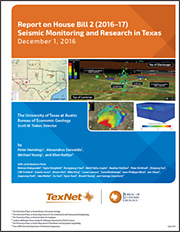Synopsis: Development of coupled geomechanics and reservoir engineering simulations that are able to assess the controls on fault rupture size and permeability evolution
Project Status: active
Funding Source: 100% TexNet
Research Leaders: Jon Olson, Mohsen Babazadeh, Rich Schultz
Project Start: 1Q2016
Project Interface: Project interfaces closely with Texas Seismicity Studies, Ft. Worth Basin Earthquake Characterization, Faults and Geomodels, Pore Pressure Analysis of Ft. Worth Basin, Seismic Hazard and Risk Assessment - Shaking Intensity, and Multi-Institutional and Industrial Collaboration for Geomechanical and Seismicity Assessment of the Ft. Worth Basin
Expected research outcomes:
- Geomechanical models relating injection volume and fault properties to potential earthquake magnitude
The magnitude of an earthquake depends on the slip and the size of the patch that slips. Simple Mohr-Coulomb analysis can only determine (albeit imperfectly) whether slip will initiate. It cannot predict the unstable rupture process that ensues after initiation. Models are described in the literature, backed up with experimental data, which describe slip weakening behavior on faults, where the sliding friction is smaller than the pre-slip static friction. Given the stress change caused by fluid injection in the vicinity of a fault that could come from hydraulic fracturing or waste-water injection wells, for both permeable and impermeable (basement) rock, we will build a numerical model that predicts the extent of rupture propagation. We will start by doing this analysis in a quasi-static manner, and then move on to truly dynamic analysis. The quasi-static approach should be possible using boundary element methods. We will need to further investigate the best way to perform dynamic analyses, although we have some considerable experience using Discrete Element Methods (DEM).
